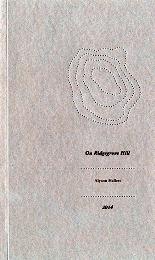Merryn Williams responds to Alyson Hallett’s poetic account of her time as poet-in-residence at Charles Causley’s house.
 On Ridgegrove Hill
Alyson Hallett (with illustrations by Phyllida Bluemel)
Atlantic Press
ISBN 978-0957154957
£10
On Ridgegrove Hill
Alyson Hallett (with illustrations by Phyllida Bluemel)
Atlantic Press
ISBN 978-0957154957
£10
Alyson Hallett was the second Charles Causley poet in residence, and the first to actually live in his house, Cyprus Well, on Ridgegrove Hill in Launceston. This very slim volume is a meditation on her time there, is designed by Phyllida Bluemel and includes a fine poem, ‘Where he lived’, by Penelope Shuttle.
Causley himself wrote about the house, named for the Saxon spring, in ‘Sibard’s Well’. He imagined a thin water of language through the clay, which had existed long before his time and would continue long afterwards. Alyson’s booklet describes her attempts to get into touch with Causley’s spirit; she searches for his grave by St Thomas Water, wakes up where he did – a house crawls out of darkness, explores the empty spaces in the churches he knew. In ‘So Steep your Legs Hurt’ she walks, or rather climbs, around his neighbourhood:
Up and down, up and down,
Angel Hill, Ridgegrove Hill,
St Stephen’s Hill. Up to Windmill Hill
where there’s no windmill
but enough sloes for this year’s gin
and a stretch of sky so high
the oxygen thins. Up and down,
up and down, the castle keep
sweeping to an edge that falls
then swiftly rises again.
There’s no hiding here.
The green-ridged hills define you,
send you plunging to the river
or soaring above the tors on Dartmoor.
This sequence very well conveys the eerie feeling we get when we revisit an empty house; she is there because of Causley, but Causley has gone. His poems remain, like the water, an inexhaustible spring.
Merryn Williams responds to Alyson Hallett’s poetic account of her time as poet-in-residence at Charles Causley’s house.
Alyson Hallett was the second Charles Causley poet in residence, and the first to actually live in his house, Cyprus Well, on Ridgegrove Hill in Launceston. This very slim volume is a meditation on her time there, is designed by Phyllida Bluemel and includes a fine poem, ‘Where he lived’, by Penelope Shuttle.
Causley himself wrote about the house, named for the Saxon spring, in ‘Sibard’s Well’. He imagined a thin water of language through the clay, which had existed long before his time and would continue long afterwards. Alyson’s booklet describes her attempts to get into touch with Causley’s spirit; she searches for his grave by St Thomas Water, wakes up where he did – a house crawls out of darkness, explores the empty spaces in the churches he knew. In ‘So Steep your Legs Hurt’ she walks, or rather climbs, around his neighbourhood:
This sequence very well conveys the eerie feeling we get when we revisit an empty house; she is there because of Causley, but Causley has gone. His poems remain, like the water, an inexhaustible spring.
By Michael Bartholomew-Biggs • authors, books, poetry reviews, year 2015 0